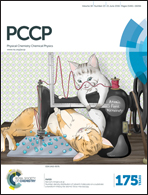The charge states of Au on gold-substituted Ce1−xO2(111) surfaces with multiple oxygen vacancies†
Abstract
The surface structures and the charge on Au for a gold atom adsorbed on the cerium vacancy of the (111) surface of CeO2 in the presence of oxygen vacancies are investigated via density functional theory calculations. Without oxygen vacancies, the Au atom adsorbed on a Ce vacancy of CeO2(111) is highly positively charged. By systematically exploring oxygen vacancy configurations, it is found that not only does the Au charge have a trend of decreasing when the number of oxygen vacancies increases, but this charge also can be significantly changed by adjusting the locations of the oxygen vacancies without altering the vacancy number. Consequently, by arranging the oxygen vacancy configuration, the Au can exist in both positive and negative states in the case of three oxygen vacancies. Detailed analyses show that the variation in the Au charge with oxygen vacancies can be attributed to the distribution of the leftover electrons after the oxygen vacancies were created, which, in turn, depends on the vacancy number and locations of the vacancies. These results suggest a potential method to adjust the oxidation states of Au atoms absorbed on ceria. In addition, the implications of the findings for experimental results are also discussed.


 Please wait while we load your content...
Please wait while we load your content...